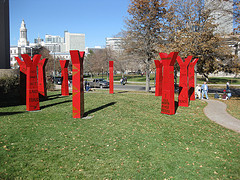When looking at the great cities of America and the world, one of the things that give these places the kind of culture and character they are often known for is public works of art. These exhibits, often unique and memorable, provide a focal point for tourists and a sense of civic pride for residents.
However, in these tough economic times, a new problem has emerged for cities everywhere: with cities struggling financially, these works of art are suffering from neglect, acts of vandalism and normal wear and tear, and often do not have the funds necessary to properly maintain them.
character they are often known for is public works of art. These exhibits, often unique and memorable, provide a focal point for tourists and a sense of civic pride for residents.
However, in these tough economic times, a new problem has emerged for cities everywhere: with cities struggling financially, these works of art are suffering from neglect, acts of vandalism and normal wear and tear, and often do not have the funds necessary to properly maintain them.
These kinds of problems are being felt in cities all across the country. In my hometown of Phoenix, a story last month in the Arizona Republic highlighted the struggle that cities are facing: public works of art are more popular than ever, but face neglect and lack of upkeep due to budget shortfalls and calls for budget austerity.
The problems associated with the upkeep of public works of art go beyond the usual wear and tear: vandalism, including graffiti, is common, along with the theft of metals and gems that are often a part of some displays. The cost to maintain and replace these works of art, especially older exhibits, can prove costly. In a citywide audit, the city of Phoenix found that dozens of public art pieces were in need of repairs, with the total renovation costs estimated to be over $1 million. While most projects were victims of vandalism or wear and tear, others experienced some unexpected problems: for example, an overpass exhibit needed almost $100,000 in repairs because of runoff water eroding parts of the project.
In November, I wrote about how public works of art were more important than ever in today’s climate of budget austerity, and the continued vandalism and destruction of these art displays adds another layer of difficulty when it comes to saving exhibits. While the upfront cost of public art displays often receive the lion’s share of attention and public outcry, the cost of vandalism and neglect often go unmentioned. The costs associated with restoration can ultimately have another impact as well: cities often have to cancel funding for new art projects to care for existing pieces badly in need of repair.
With cities facing decreased tax collections in recent years, the money to help maintain and preserve public works of art is severely lacking. Some cities, including those in the Phoenix metropolitan area, require a certain percentage of money from construction projects be devoted to public art, which in robust economic times provides a stable source of revenue for new art construction and upkeep. The problem, however, is that during tough economic times, less construction projects are taking place, which means that the funding for public art dries up. In a state like Arizona, which was devastated by the housing bubble, the impact can be quite substantial. As the Arizona Republic reported, the difference in funding levels can be quite severe: in the city of Phoenix, the budget for maintenance and restoration went from $63,000 in 2008-09 to just $29,000 in 2011-12. The problem was even more severe in Tempe, home to Arizona State University: the budget went from $90,000 in 2008-09 to just under $8,000 in 2011-12.
So with city funding for upkeep and restoration limited in these tough economic times, what kinds of solutions are available to save public works of art? One option is to raise money through increased taxes; while tax increases are often unpopular, they could be levied in such a way that the impact would be negligible on residents. Examples could include taxes on travel expenses, like car rentals and hotels, or on city services like utility bills. Another option is for cities to seek grants from non-profit and private sources; while most cities seek private funds to sponsor new works of art, efforts to help beautify existing works of art can help promote civic pride and improve areas already in use.
And while they certainly have access to more capital and resources, cities and local governments are not the only people that can have an impact. Residents and community groups are often getting involved as well; helping to “sponsor” an exhibit can often have just as much of an impact. By painting over graffiti, picking up waste or helping to raise money for upkeep, ordinary citizens can promote and protect their community’s works of art. As more and more pieces face neglect and vandalism, residents often feel the urge to protect the town they call home.
Public art projects often serve as a way to remind residents and visitors alike of the culture and history of that particular place. In these tough economic times, these exhibits and projects are in danger of being neglected entirely, damaging not only the art itself, but also the civic pride of residents all across the country.
(Photo: CC by Mal Booth)
